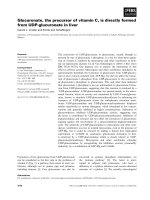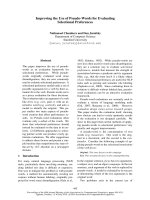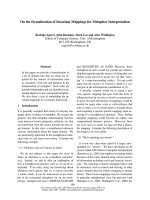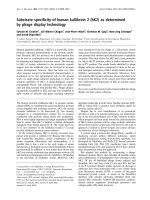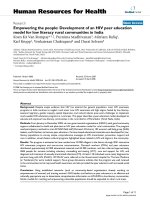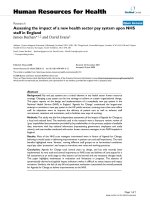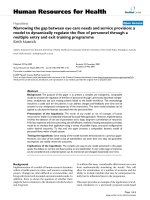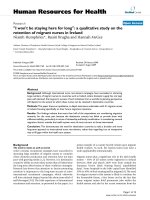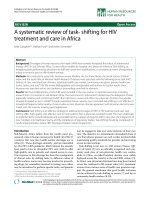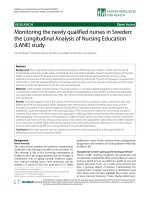báo cáo sinh học:" Costing the scaling-up of human resources for health: lessons from Mozambique and Guinea Bissau" docx
Bạn đang xem bản rút gọn của tài liệu. Xem và tải ngay bản đầy đủ của tài liệu tại đây (573.3 KB, 10 trang )
Tyrrell et al. Human Resources for Health 2010, 8:14
/>Open Access
METHODOLOGY
© 2010 Tyrrell et al; licensee BioMed Central Ltd. This is an Open Access article distributed under the terms of the Creative Commons
Attribution License ( which permits unrestricted use, distribution, and reproduction in
any medium, provided the original work is properly cited.
Methodology
Costing the scaling-up of human resources for
health: lessons from Mozambique and Guinea
Bissau
Amanda K Tyrrell
1
, Giuliano Russo*
2
, Gilles Dussault
2
and Paulo Ferrinho
2
Abstract
Introduction: In the context of the current human resources for health (HRH) crisis, the need for comprehensive
Human Resources Development Plans (HRDP) is acute, especially in resource-scarce sub-Saharan African countries.
However, the financial implications of such plans rarely receive due consideration, despite the availability of much
advice and examples in the literature on how to conduct HRDP costing. Global initiatives have also been launched
recently to standardise costing methodologies and respective tools.
Methods: This paper reports on two separate experiences of HRDP costing in Mozambique and Guinea Bissau, with
the objective to provide an insight into the practice of costing exercises in information-poor settings, as well as to
contribute to the existing debate on HRH costing methodologies. The study adopts a case-study approach to analyse
the methodologies developed in the two countries, their contexts, policy processes and actors involved.
Results: From the analysis of the two cases, it emerged that the costing exercises represented an important driver of
the HRDP elaboration, which lent credibility to the process, and provided a financial framework within which HRH
policies could be discussed. In both cases, bottom-up and country-specific methods were designed to overcome the
countries' lack of cost and financing data, as well as to interpret their financial systems. Such an approach also allowed
the costing exercises to feed directly into the national planning and budgeting process.
Conclusions: The authors conclude that bottom-up and country-specific costing methodologies have the potential to
serve adequately the multi-faceted purpose of the exercise. It is recognised that standardised tools and methodologies
may help reduce local governments' dependency on foreign expertise to conduct the HRDP costing and facilitate
regional and international comparisons. However, adopting pre-defined and insufficiently flexible tools may
undermine the credibility of the costing exercise, and reduce the space for policy negotiation opportunities within the
HRDP elaboration process.
Introduction
It is widely accepted that a dramatic expansion of the
health workforce worldwide, and in particular for sub-
Saharan Africa, is necessary to achieve universal coverage
by health services. What remains problematic is how this
expansion can be achieved in countries with limited
financial resources and inadequate training capacity.
This paper presents and discusses two separate human
resources for health (HRH) costing exercises carried out
in the context of the elaboration of national human
resources development strategies. The paper's objective
is to present and analyze two separate examples on the
elaboration of costing exercises in information-poor set-
tings, and illustrate how the lack of HRH financial and
cost data was overcome in Mozambique and Guinea Bis-
sau. The paper's ultimate goal is to contribute to the
debate on costing tools and strategies, and more specifi-
cally to identify advantages and disadvantages of certain
key methodological aspects. In doing so, it highlights the
importance of adapting any costing methodology to spe-
cific country needs and contexts.
HRH costing methodologies recommended in the liter-
ature are briefly reviewed in the first part of the docu-
* Correspondence:
2
Department of International Health, Instituto de Higiene e Medicina Tropical,
Rua da Junqueira 100, Lisbon, 1349-0008 Portugal
Full list of author information is available at the end of the article
Tyrrell et al. Human Resources for Health 2010, 8:14
/>Page 2 of 10
ment, followed by a description of the case study
methodology used to compare the Mozambican and
Guinean Bissau costing of the national scaling-up of the
health workforce. The context, process and actors
involved in the Mozambique and Guinea Bissau case
studies are then presented along with the results of the
costing exercises. The discussion highlights the lessons
learned and stresses the advantages of selecting country-
specific costing tools.
Literature review
Martineau et al (2008) highlight the importance for low-
income countries to develop a clear strategy to develop
their health workforce, including a projection of costs
over a multi-year period [1]. A 'costed' plan is credited
with helping identify financing gaps and serving as an
advocacy tool in the process of mobilizing resources. The
classical approach to planning and costing Human
Resources Development Plans (HRDP) in the health sec-
tor involves four steps: (a) estimating the numbers of
additional staff needed; (b) multiplying those numbers by
current and future public sector salaries and allowances;
(c) calculating financial needs on the basis of projected
available funds, and (d) discussing financing options [2].
However, this 'rational' approach does not take into
account the dynamics of the labour market, and often
ignores health personnel's propensity to emigrate. Bloor
and Maynard consider it important to factor in the supply
and demand of health personnel in the public and private
sector [3]. Rutten argues that HRH planning should adopt
general equilibrium models bringing together labour
market factors and funds availability [4].
The World Health Organization (WHO) has recogn-
ised the importance of the issue, and launched initiatives
such as the Working Group on Tools and Guidelines to
strengthen the analysis of the costs of HRH development
[5], and to propose guidelines. The Global Health Work-
force Alliance (GHWA) supported the development of a
Resource Requirements Tool (RRT) to help local govern-
ments estimate the costs of HRH plans and policies [6].
The RRT provides a methodology to collect information
on HRH and on the local economy, including labour mar-
kets, and the tool is organised in an Excel-based file
divided into data-entry, scenario and output sheets. By
initially taking the calculated HR requirements from
national HRH plans, the tool helps calculate and project
the costs of different HRH training and recruitment
options available to local Governments [7]. The tool cal-
culates salary and incentives (financial, as well as the
monetary value of non-financial incentives, such as free
meals, transport, and accommodation), as well as initial
training, capital and equipment expenses, and compares
them with the projected funds availability. The concept of
'fiscal space', i.e. a country's ability to find the financial
resources required to finance the anticipated spending[8],
- is evaluated by taking into account the country's
expected economic growth, the current level of GDP, the
share of Government resources allocated to health, and
the share of health spending devoted to personnel [9].
The RRT also takes into account the number of HRH
employed in the private sector, but not consumers' will-
ingness to pay for health services, nor the possible inter-
actions between public and private providers.
Recent work shows that many National HRH Strategies
fail to include a comprehensive review of costs: this is the
case for Eritrea, Rwanda, Sierra Leone, Zambia, South
Africa and Sudan [10,11]. In fact, there are few docu-
mented examples of costing such strategies in low-
income countries. In the following sections, the paper
describes the methodologies used and the lessons learned
from two separate case studies in Mozambique and
Guinea Bissau, and tries to relate them with the theoreti-
cal work currently being developed on the subject.
Methods
Two separate costing exercises were conducted in
Mozambique [12] and Guinea Bissau [13] between 2007
and 2009, at the request of the respective health authori-
ties. For the two exercises, the authors developed distinct,
context-specific methodologies taking into account the
countries' financial reporting systems and availability of
cost information. The description of how such exercises
were conducted, and of the resulting costing methodolo-
gies that were developed, constitutes the basis of the
present paper.
A descriptive multi-case study approach [14] was
selected to compare the two experiences and answer the
following questions: (a) what to do and how to do it when
undertaking HRH plans costing; and (b) what conditions
need to be in place to enable a successful costing exercise.
The two case studies were analysed and compared, and
lessons were extracted from the two distinct exercises
focusing on the context, on the elaboration process, on
the actors involved, on the methodological approach, and
on the specific problems that each methodology had to
overcome. A framework was adapted from Walt and Gil-
son [15] to analyse the following methodological and pol-
icy-making dimensions from the two cases: (a) the
methodologies developed for HRH costing; (b) policy
contexts and environments; (c) policy processes; and (d)
actors involved. A recent review (Gilson et al. 2008) con-
cluded that such an approach is effective to analyze
diverse policy initiatives in different contexts [16,17].
The costing studies were conducted independently in
the two Portuguese-speaking countries, in collaboration
with the international and national teams responsible for
the development of HRH plans. Information was col-
lected through interviews with policy makers, health
Tyrrell et al. Human Resources for Health 2010, 8:14
/>Page 3 of 10
managers, and other relevant stakeholders, as well as
through documental analysis. Sources of information
used were: (a) human resources projections where avail-
able; (b) official salary tables and any additional relevant
documentation on salaries' policy; (c) HRH training pro-
gramme funding data; and (d) domestic budget and exter-
nal aid data.
Results
Costing HRH projections in Mozambique
Context, process and actors involved
Since the end of the war in 1992, Mozambique has pro-
gressively been rebuilding its health network, through
reconstruction and rehabilitation of physical infrastruc-
tures, as well as training and recruitment of its health
workforce. The country is still characterized by a high
burden of disease, and faces the challenge of an unre-
formed health system, including a severe deficit of HRH
in all categories of workers [18]. The elaboration of
Mozambique's health sector's Human Resources Devel-
opment Plan (HRDP) 2008-15 was developed in the con-
text of strong political commitment from the
Government to alleviate poverty and to achieve the Mil-
lennium Development Goals (MDGs).
At the time of elaboration of the plan (2007-2008), the
Government of Mozambique was engaged in the process
of designing a new salaries policy for public servants,
with a potentially significant impact on the wage bill
across sectors. Donors financed a number of salary top
ups, incentives and a limited number of salaries through a
common funding mechanism (PROSAUDE, that is, the
Health Sector-Wide Approach fund), as well as direct
financing to provincial authorities, but the government
essentially financed the wage bill. The development of the
HRDP aimed at increasing access and quality of services
to the population, particularly in remote and disadvan-
taged areas. Both the Ministry of Health and develop-
ment partners were committed to the process, and
considered the costing exercise an integral part of the
plan, as the two were developed in concurrence by the
same team of consultants. Financial implications of dif-
ferent scenarios, based on the number of workers to be
trained and recruited and on varying salary levels, served
as a basis for policy discussions and informed the final
decisions on the plan's proposals.
The main objectives of the costing exercise were: (a) to
analyse current levels of expenditure on HRH, both from
internal and external sources; (b) to calculate the real cost
of training in the health sector, including initial and on-
the job training (or continuous medical education), post-
graduate training and scholarships, and; (c) to calculate
the cost of different scenarios of HRH development until
2015, based on the HRH strategy and other relevant
existing policy documents (e.g. government salaries pol-
icy, incentives policy).
The costing exercise took place from late 2007 until
mid-2008, and was supported by a team of external spe-
cialists (a senior human resources specialist, a statisti-
cian, and a health economist), who visited Mozambique
on a number of occasions and for relatively long periods
(two months). The focal point in the Ministry of Health
(MoH) was the Human Resources Department. One key
source of information was the National Health Institute,
where detailed cost data was collected, analysed, and
crosschecked with expenditure information at the MoH
on other training institutions across the country, in order
to calculate unit costs of training.
Methodology used in Mozambique
Cost projections were based in large part on the training
outputs and salary increase targets already defined for the
HRDP. Personnel projections took into account attrition
rates due to deaths, retirement, and moves to the private
sector, including to international organisations and
NGOs. Macroeconomic data, such as annual inflation
and exchange rates were based on the government's Mid-
Term Expenditure Framework (MTEF) 2008-10. Where
possible, a bottom up approach was adopted, which
implied collecting cost data at the grassroots, and com-
bining unit costs with input quantities in order to gener-
ate total costs. Where data were limited or unavailable, a
step-down methodology was used, breaking down costs
to the smallest possible denominator. Emphasis was put
on ensuring that revisions of the projections could easily
be made in the future, as new data became available or
unforeseen changes affected the costs significantly.
Future costs and expenditures were calculated in real and
nominal terms according to the formula: Present value*
(1+i)
n
.
Spending projections were calculated through a set of
costing sheets in Excel to match the needs of the sector in
terms of relevant cost components, classification of
expenditure, and the structure and content of existing
information, such as the government salary levels classifi-
cation. Where relevant and possible, the sheets were
interlinked through a set of simple formulae and refer-
ences in order to ensure that any change in inputs (e.g.
number of students) was reflected in outputs (e.g. annual
health workforce). Besides HRH typical recurrent costs
such as salary or training expenditures, capital expendi-
tures were also included, as these were considered key to
scaling-up the national health workforce. Capital invest-
ments were identified on the basis of information
obtained from the infrastructure department of the MoH.
They corresponded to the cost (estimated by MoH) to
expand and rehabilitate the physical health network,
including capital works (secondary care hospitals) and
Tyrrell et al. Human Resources for Health 2010, 8:14
/>Page 4 of 10
equipment (scanners, x-ray machines, etc.). Only the pur-
chase cost of tangible assets used to strengthen the train-
ing network were estimated (e.g. building and equipping
of training institutions); the exercise did not attempt to
include an estimation of the accounting value of assets. It
was also assumed that those assets with a life span longer
than the study's expenditure projections were not going
to need replacing. Maintenance costs for the health sys-
tem as a whole were included in the broader costing of
the health strategy and were taken into account in this
section to avoid double counting.
The set of detailed sheets was subsequently aggregated
to present the summary of planned expenditure per area
of HRH over the years. Figure 1 illustrates the rationale
behind the costing model developed, and the table in
Additional file 1 is the summary of cost components and
sub-components identified and sources of information.
Salaries and allowances (the wage bill) included workers'
base salary and legal supplements, such as subsidies for
working in remote areas, for management positions,
working extra hours, etc. Additional incentives were con-
sidered to be those relating to civil servants also spon-
sored by donors. In the absence of a finalized incentives
policy, the critical assumption was made that the value of
incentives summed up at least 26% of the salary mass.
Training costs were divided into four sub-components,
namely initial and on-the-job training, postgraduate
training and scholarships. Recurrent and capital expendi-
ture were considered where relevant. For initial training,
in the absence of specific targets for the number of bene-
ficiaries and number of courses, assumptions were made
to derive the number of beneficiaries, on the basis of the
analysis of courses offered to date and of the specialties to
be prioritized. Other important components of cost of
the HRDP were foreign doctors, Community Health
Workers (CHW), technical assistance, and other associ-
ated expenditures (Figure 1).
The total cost of the HRDP was estimated at approxi-
mately two billion USD over 8 years, of which over three
quarters were planned to finance the wage bill, and
another 14% the incentives package to support worker
deployment, motivation and retention (Figure 2).
Although in relative terms the planned expenditure in
other areas of HRH appears small, a total of over 100 mil-
lion US dollars was estimated necessary for initial train-
ing between 2008-15, of which 28% for infrastructure and
equipment; and 11 million US dollars were dedicated to
on-the-job training. The estimated cost of foreign doc-
tors amounted to 43 million, the annual value reducing
considerably between 2008 and 2015, under the assump-
Figure 1 Illustration of the rationale of the Mozambique HRH costing model. Source: Tyrrell (2008) 12.
Tyrrell et al. Human Resources for Health 2010, 8:14
/>Page 5 of 10
tion that, as the country increases its capacity to train
national doctors, there will be less of a need to contract
foreign ones. In addition to costs directly associated with
scaling up the health workforce between 2008 and 2015,
it was estimated that almost one billion USD would be
necessary for infrastructure and equipment, in order to
enable complete timely implementation of the HRDP.
Three scenarios were developed to estimate HRH
needs, varying the criteria used for personnel projections.
Given the uncertainty regarding the salaries policy, a sen-
sitivity analysis was performed, altering assumptions on
salary increases for different levels and categories of
workers, to reflect the different salary policy options in
negotiation [19]. The scenarios varied from an average of
1410 graduates per year, producing the lowest number of
workers by 2015 (39 638), and costing an average of 158
million USD annually, to 2036 graduated per year, at an
average cost of 174 million USD. In the end, the govern-
ment chose the most costly scenario, where the health
workforce was increased by 44% (from 25 683 in 2006 to
45 654), based on staffing norms and on priority to work-
ers in MDG-related areas.
The costing exercise uncovered that expenditure on
HRH would have to increase from 50 million US dollars
in 2006 to 400 million US dollars in 2015 in order to
accommodate the training targets, increasing steadily
over the years. The eight-fold increase in the cost fore-
seen over nine years is primarily due to the plan's stated
objectives of rapidly scaling up the health workforce (at
an average rate of over 2200 workers per year), while at
the same time guaranteeing adequate remuneration to
workers, particularly for those professionals operating in
remote, more disadvantaged areas, and in priority spe-
cialties for the attainment of the MDGs.
Since its completion, data from the costing exercise
have been used to update the costing of the Health Sector
Strategic Plan and the Medium Term Expenditure Frame-
work (MTEF). It also served to prepare the budget for the
Health Systems Strengthening (HSS) component of
Mozambique's HIV/AIDS proposal to Round 9 of
GFATM, still awaiting grant signature.
The HRH plan costing in Guinea Bissau
Context, process and actors involved
At the time of elaboration of its HRH plan, Guinea Bissau
was going through a deep political and social crisis, which
impacted significantly on HRH planning and manage-
ment. Ferrinho (2009) estimated that without scaling-up
training and recruitment, HRH were projected to
decrease from 2010 onwards [20]. The fragility of the sit-
uation was exacerbated by the fact that, since indepen-
dence, donors had exclusively, and to a very limited scale,
Figure 2 Total projected HRH expenditure by component, Mozambique (2008-2015). Source: Tyrrell (2008) 12.
Salaries and
allowances 76%
In
centives 14%
Foreign
do
ctors 2%
Pr
e-service training
5%
In-service training
1%
Scholarships and
postgraduation 1%
Human resources
management (HRM)
<1%
Communty health
workers <1%
Support to the
implementation of
HRDP 1%
Tyrrell et al. Human Resources for Health 2010, 8:14
/>Page 6 of 10
supported HRH training, whereas the government paid
the wage bill, usually with delays of many months.
Local capacity for the elaboration of the HRH develop-
ment plan (HRDP), and in particular to conduct its cost-
ing, was low. No economic data existed on the cost of
training, or on the overall level of external funds available
to support it. The costing exercise was designed as an
iterative process, and as part of the development of the
main HRDP. Preliminary findings on budget ceilings and
cost implications provided an input into the elaboration
of the main HRDP, and the costing report was later
adapted to incorporate the policy options selected in the
plan [21].
The HRH costing objectives were: (a) to identify cur-
rent budget ceilings, and to calculate what policies were
financially feasible within the existing resource envelope;
(b) to calculate current training costs; (c) to identify the
financial implications of scaling-up for each funding
source, and; (c) to act as a catalyst in the elaboration of
the main plan, and in raising funds [22].
The MoH's Vice-Minister and a senior external consul-
tant were the key leaders of the HRDP exercise, assuming
the responsibility of mobilising resources for the elabora-
tion of the plan, and of advocating for the importance of
HRH costing as a policy tool. Within the MoH, the
Human Resources Department acted as the focal point,
providing linkage between consultants and other actors,
as well as punctual input in the HRH costing. The MoH
Financial Department provided financial information
coming from the Ministry of Finance's Budget Depart-
ment. Personnel of the Faculdade de Medicina Raul Diaz
Arguellez Medicine School and of the National School of
Health were key informants for the identification of train-
ing costs. Representatives of aid agencies were supportive
but sceptical as to the chances of success of the process of
elaboration of an HRH strategy for the country.
The final costing exercise was generally well received by
the MoH, although little contributions were made to the
documents, as the matter was considered too technical
for the human resource department. Shortly after, the
final HRDP was elaborated, and both the HRDP and its
costing have now been formally adopted by the MoH,
although not yet formally approved by the Council of
Ministers.
Methodology used in Guinea Bissau
Cost projections were based on targets already defined
for the HRDP. Personnel projections took into account
attrition rates due to deaths and retirement. In a context
of scarcity of information on labour market demand and
supply, bottom-up and step-down costing were used; the
former was employed more frequently, as the costs of
most training and funding activities had to be calculated.
Only recurrent expenditures were considered for pre-
service and on-the-job training (elsewhere referred to as
"Continuous Medical Education"), excluding capital and
investment costs, as the focus of the exercise was on the
financial feasibility of training and recruiting a minimum
number of staff; training facilities investment plans were
discussed separately [23]. The assumption was made that
the public sector would be able to absorb all new staff
trained, with no losses to the private sector or to emigra-
tion. Only external funds under the direct control of the
MoH were considered as external funds available to
finance the HRDP (also known as 'funds for the imple-
mentation of the second national health sector develop-
ment plan'). These included grants/loans from the World
Bank, the African Development Bank and the Global
Fund for Aids, Malaria and Tuberculosis. Since the
majority of donors' funds for health were fragmented in
numerous in-house-managed projects, information on a
significant share of external funds for HRH training could
not be included in the study.
Steps taken to calculate the financial resources needed
to train and contract new health personnel were the fol-
lowing: (1) projecting the HRH needs to achieve mini-
mum staff requirements in the public sector for the next
10 years; (2) calculating unit costs of training for each
type of personnel; (3) budgeting the salary bill for each
year of planning; (4) forecasting availability of internal
and external funds, and; (5) constructing an expenditures
and funds database and modelling financing scenarios.
HRH needs were available from a previous assessment
of HRH on the field [24]. The number of training courses
needed to produce the required output was calculated
working bottom-up with the financial and planning offi-
cers from the local National School of Health, and from
the Faculty of Medicine. For courses offered in the past
(nurses, midwifes, physicians, laboratory and pharmacy
technicians), cost data were extracted from balance
sheets and funding documents. For courses not yet avail-
able (specialists, anaesthesia and surgery technicians), the
monetary value of grants to support studies abroad were
calculated with the help of those aid agencies offering
such grants (WHO, the Cuban Embassy and Portuguese
Cooperation). The inputs for training were: teacher sala-
ries and allowances, student transport and living allow-
ances, books, equipment and equipment maintenance.
Figure 3 shows that, generally speaking, training profes-
sionals locally in Guinea Bissau is cheaper than training
them abroad, with physicians trained by the Cuban bri-
gade at an overall cost of US$ 10 133 each for a 5-year
course (the Cuban Embassy currently supports the Guin-
ean health sector through a brigade of general practitio-
ners and specialists, who, besides working in the local
central hospital, teach at the Faculdade de Medicina Raul
Diaz Arguellez Medical School). Physicians with a Guin-
ean medical degree going abroad (to Portugal) to special-
ize in paediatrics were the most expensive category to
Tyrrell et al. Human Resources for Health 2010, 8:14
/>Page 7 of 10
train, with a cost of US$ 83 070 for a 6-year course in pae-
diatrics.
On-the-job training, an activity not currently carried
out, was calculated as representing five days of training
per year for existing and future staff (excluding auxilia-
ries). Cost inputs considered were: teacher remuneration,
transport, trainee living allowances and teaching equip-
ment.
Data on basic salary and subsidies (for work in remote
areas and extra hours) were obtained from the Ministry
of Planning and Finance, and matched with previous
years state budgets for health personnel [25]. State budget
and external funds financing ceilings were projected from
historical expenditures and funds available through the
MoH National Health Plan Financing and Implementa-
tion Unit.
An expenditure and financing database was built in
Excel, including variables on type and number of person-
nel to be trained and contracted each year, total expendi-
ture, source of funding, category of personnel, and type of
expenditure. Through pivot table reports, the database
allowed for modelling two expenditure and financing sce-
narios: one calculated the financial burden for state and
donors of training and contracting all the HRHs required
to achieve the minimum staff in all NHS facilities. The
second scenario calculated the financial implications and
funding gaps of a hypothetical salary policy raising by
25% the remuneration of specialised personnel, and by
10% that of mid-level. Both scenarios were compared to
projected available state and external funds, and funding
gaps were estimated.
Costing and expenditure projections were done in con-
stant base-year prices, as well as in current prices until
2017, taking into account the forecasted inflation rate
(according to the formula: Future value = Present value*
(1+i)
n
, with the rationale of providing the MoH with an
updated tool to negotiate year-on-year future personnel
funding needs.
The base scenario (Scenario 1) demonstrated that a
considerable gap existed between the cost of the full plan
and available funds, particularly with respect to the state
funds needed to contract new health workers. The pro-
jections suggested that in order to close that gap, State
funds were required to grow by 6.4% annually in real
terms (Figure 4).
As for external funds, an issue of year-on-year availabil-
ity was identified, rather than one of absolute scarcity, as
training expenditures were anticipated to cumulate dur-
Figure 3 Training cost for specific HRH in/for Guinea Bissau (2009 US$ constant prices). Source: Russo and Ferrinho (2009) 13.
Tyrrell et al. Human Resources for Health 2010, 8:14
/>Page 8 of 10
ing the first few years, leaving a financing gap that could
be closed only in 2012 (Figure 4).
Differences and similarities between the costing exercises
in Mozambique and Guinea Bissau
The two HRDP costing exercises presented above showed
key similarities and differences worth highlighting in
order to draw lessons for the wider debate on HRH cost-
ing methodologies (Additional file 1: Table S1). First,
although apparently similar, the two countries' contexts
were uncovered to be remarkably different. On the one
hand, Mozambique displayed the characteristics of a
post-conflict country, with an emerging post-war middle
class, donor aid focussing on the health sector, and an
explicit government commitment towards 'social' sectors.
On the other hand, at the time of the costing exercise
Guinea Bissau was still seen as deeply embroiled in politi-
cal instability, with a looming HRH crisis, and with lim-
ited donor interest in financing an HRH development
plan.
In both case studies, costing was conceived as part of a
larger planning and fund-raising effort, which in Mozam-
bique was chiefly aimed at extracting salary concessions
from the Government's MPF and additional pledges from
the international community, while in Guinea Bissau the
exercise's focus was more on drawing attention to the
health sector's impending human resources crises. Given
the declared lack of local health economists and planners,
both exercises were developed by a team of international
experts with limited participation from local staff.
In both cases, a bottom-up approach was selected to
carry out the costing, given the scarcity of information on
training unit cost and financial data on the sector's
human resources. Simple Excel-based models were
designed specifically for both exercises, either creating
multiple linked sheets, or a database with respective pivot
tables. Both exercises considered mostly basic human
resources spending areas, such as initial and on-the-job
training, as well as grants to train abroad. In Mozam-
bique, the methodology also included the investment
costs of expanding the physical training network. This
was not possible in Guinea Bissau as, at the time of the
costing exercise, strategic decisions on the final configu-
ration of the facilities network were still pending. Sala-
ries, subsidies, training equipment, and scholarships were
the cost categories covered in both exercises.
Figure 4 Guinea Bissau HRH plan's projected expenditures and funding (2009 US$). Source: Russo and Ferrinho 2009 13.
Tyrrell et al. Human Resources for Health 2010, 8:14
/>Page 9 of 10
In both Mozambique and Guinea Bissau, the conclud-
ing spending and financing scenarios were designed to
evaluate the fiscal impact of HRH policies of interest. For
Mozambique, such scenarios were chiefly used to high-
light the wide funding gap between identified needs and
available resources, with the objective to make an explicit
call for extra funds. In Guinea Bissau, the chosen scenar-
ios modelling selected HRH policies and respective fund-
ing needs were to some extent more conservative, due to
the country's less favourable financing environment and
limited training capacity.
Discussion
This study's methodology, used to compare the Mozam-
bican and Guinean experiences, presents a number of
limitations. First, as the two case studies are based on
previous work, a policy analysis framework was only
applied retrospectively. As the study methods were not
applied to design the original fieldwork, but only to inter-
pret its results, the depth and internal validity of our anal-
ysis may be limited. Secondly, due to their Portuguese
cultural heritage and country's current political situation,
the Mozambican and Guinean health systems present
very specific features, which may limit the generalisation
of the study findings to other contexts. Despite these lim-
itations, a number of lessons from the case studies can be
considered valid and possibly applicable to other con-
texts.
The study primarily shows that costing is part of the
more general HRDP process, not a self-standing eco-
nomic exercise. In Mozambique and Guinea Bissau, HRH
costing had multiple objectives: (a) to contribute to extra-
health agendas such as public sector salaries, subsidies
and incentives policies; (b) to identify wage inequalities;
(c) to engage government and external partners in a
debate on resources needed for HRH development; (d) to
create consensus on the HRDP's validity and relevance;
(e) to provide a long-term vision of resource needs for the
Ministries of Health; (f ) to help define HRH policies, pro-
viding MoH managers with essential financial informa-
tion, and; (g) to help raise funds from the international
community. All in all, bringing costs and financial impli-
cations into the HRDP equation helped to avoid overam-
bitious plans for workforce expansion, and to show that
current spending commitments were insufficient. This is
consistent with calls from many scholars for HRH plan-
ning to be 'strategic' [1].
The analysis of the two case studies also suggests that
the costing methodology needs to be simple and flexible,
to cover basic spending areas, and to allow for the evalua-
tion of different policy scenarios' financial and political
feasibility. The majority of data on external funds and
training input costs were not readily available, and had to
be calculated. A significant amount of time had to be
spent with local financial officers to interpret financial
reporting systems and to identify adequate cost appor-
tioning methods. The implication of this is that the two
methodologies had to resort to both top down and bot-
tom up accounting, which allow for more reliable, if time-
consuming, cost calculations [26,27]. Furthermore, only
the basic areas of wage bills, initial and on-the-job-train-
ing (elsewhere referred to as 'continuous medical educa-
tion'), and capital investment were considered.
Restricting the expenditure areas considerably simplified
the task, but also made possible the evaluation of alterna-
tive policy scenarios, such as increasing/decreasing the
number of personnel, increasing training capacity and
raising or decompressing salaries under different funding
ceilings.
The present study intends to contribute to the debate
on resource requirements tools (RRT) for HRH planning.
Our study supports the WHO approach of developing a
standardised costing approach, in order to reduce local
governments' dependency on international experts [5].
However, by highlighting the importance of costing in the
general HRDP elaboration process, this study also raises
doubts on the opportunity of limiting the task to entering
cost data in standard software.
The lack of flexibility of the RRT is called into question,
especially with regard to the categorisation of incentive
payments and allowances. The RRT's inability to inter-
pret and adapt to local financial situations may jeopardise
the whole HRDP process, since the understanding of a
country's flows of funds and respective financial informa-
tion system is what lends the exercise the credibility to
achieve its policy goals. Furthermore, the RRT appears at
times unnecessarily complicated, bringing into the exer-
cise complex issues such as the private sector health
workforce, but dealing only partially with the overall
national demand of human resources and health workers'
dual practice.
If priority is to be given to developing an approach tai-
lored to each context, regional and international compar-
isons may not be easy to carry out, and a significant
amount of resources may have to be devoted to costing
exercises. However, such types of investment may be
required to address the health workforce crisis effectively
and to design comprehensive and long-term solutions.
Conclusions
This study compared two separate costing exercises con-
ducted in Mozambique and Guinea Bissau, with the
objective to contribute to the existing debate on HRH
costing methodologies. The adoption of a policy-oriented
analysis framework implied that the two countries' policy
contexts, processes and actors involved were factored
into the analysis of the methodologies developed.
Tyrrell et al. Human Resources for Health 2010, 8:14
/>Page 10 of 10
We conclude that a HRDP costing methodology needs
to be integrated in the general HRH plan elaboration pro-
cess, to be simple and flexible and as country-specific as
possible. While recognising the value of designing
generic approaches and tools, the case studies show that a
successful HRH costing methodology is a balancing act
between simplicity, relevance and comprehensiveness,
which may be difficult to achieve through a standardised
software-based approach.
More research and case study analysis appears to be
needed to understand how HRH costing can be turned
into simple, standardised, policy-supportive exercises,
performed by national teams, without losing its country-
specificity and relevance.
Additional material
Competing interests
The authors declare that they have no competing interests.
Authors' contributions
AKT carried out part of the fieldwork, participated in the study conception and
in drafting the manuscript. GR participated in the design of the study, carried
out part of the fieldwork, drafted and edited the manuscript. GD participated
in the study conception and design, and in drafting and editing the manu-
script. PF participated in the fieldwork and in editing the manuscript. All
authors read and approved the final manuscript.
Acknowledgements
AKT's fieldwork was financed by a DfID grant to assist the MoH of Mozambique
in the elaboration of the National Human Resources Development Plan. GR's
fieldwork was financed by a World Bank grant to the MoH of Guinea Bissau.
Author Details
1
World Health Organization Representative Office, 63 Tran Hung Dao Street
Hanoi 10000, PO Box 52, Viet Nam and
2
Department of International Health,
Instituto de Higiene e Medicina Tropical, Rua da Junqueira 100, Lisbon, 1349-
0008 Portugal
References
1. Martineau T, Caffrey L: Human Resources for Health Strategic Planning.
In Capacity Project Technical Brief No. 9 2008 Chapel Hill NC: Capacity
Project; 2008.
2. Glassman A, Becker , Makinen M, De Ferranti D: Planning and costing
human resources for health. The Lancet 2008, 371:93-695.
3. Bloor K, Maynard A: Planning human resources in health care: Towards
an economic approach. An international comparative review. In
Canadian Health Services Research Foundation Ottawa, Ontario; 2003.
4. Rutten M: Towards a comprehensive economic methodology for
estimating the cost of human resources for health under alternative
scenarios. In KIT Working Papers. Series H2 Amsterdam: KIT; 2008.
5. WHO: New Task Force Launched to Address Human resources
Financing. 2008 [ />np02/en/index.html].
6. GHWA: Financing and economic aspects of health workforce scale-up
and improvement: framework paper. In Task Force on Human Resources
for Health Financing 2009a Global Health Workforce Alliance. Geneva.
7. GHWA: Herramienta de requerimento de recursos humanos para la
salud. In Versión 1.1. Task Force on Human Resources for Health Financing
2009b Global Health Workforce Alliance. Geneva; 2009.
8. Heller PS: The prospect of creating 'fiscal space' for the health sector.
Health Policy and Planning 2006, 21(2):75-79.
9. GHWA: Data collection guide for the RRT. In Task Force on Human
Resources for Health Financing, 2009c Global Health Workforce Alliance.
Geneva; 2009.
10. Vujicic M, Ohiri K, Sparkes S: Working in Health: Financing and Managing
the Public Sector Health Workforce. [ />PU86PVIEU0]. The World Bank, 2009, Washington D.C
11. Vujicic M, Ohiri K, Sparkes S: Working in Health: Financing and Managing
the Public Sector Health Workforce. Published by The World Bank; 2009.
12. Tyrrell A: Estimativa de Custos do Plano Nacional de Desenvolvimento
dos Recursos Humanos da Saúde de Moçambique. In LATH report 2008
Liverpool Associates for Tropical Health. Liverpool; 2008.
13. Russo G, Ferrinho P: Os custos e o financiamento do desenvolvimento
dos recursos humanos da saúde em Guiné-Bissau. In IHMT Report 2009
Instituto de Higiene e Medicina Tropical, Lisboa; 2009.
14. Yin R: Case-study research: design and methods. In Applied Social
Research Methods Volume 5. Third edition. Sage Publications; 2003.
15. Walt G, Gilson L: Reforming the health sector in developing countries:
the central role of policy analysis. Health Policy and Planning 1994,
9(4):353-370.
16. Tantivess S, Walt J: The role of state and non-state actors in the policy
process: the contribution of policy networks to the scale-up of
antiretroviral therapy in Thailand. Health Policy and Planning 2008,
23:328-338.
17. Crichton J: Changing fortunes: analysis of fluctuating policy space for
family planning in Kenya. Health Policy and Planning 2008, 23:339-350.
18. MISAU: Plano de Nacional de Desenvolvimento de Recursos Humanos
da Saúde 2008-2015. National Human Resources Directorate, MISAU.
Maputo, August 2008. (2008)
19. MFP/MPD/MF: Parìmetros para o Desenvolvimento da Política Salarial
para a Função Pública em Moçambique. Moçambique; 2007.
20. Ferrinho P: Justificação para um pacote de ajuda de emergência ao
sector de Saúde da Guiné-Bissau. Instituto de Higiene e Medicina
Tropical. Lisboa; 2009.
21. Russo G, Ferrinho P: Os custos e o financiamento do desenvolvimento
dos recursos humanos da saúde em Guiné-Bissau. In IHMT Report 2009
Instituto de Higiene e Medicina Tropical, Lisboa; 2009.
22. IHMT and MINSAP: Termos de referência para o custeamento do
desenvolvimento sanitário e dos recursos humanos da Saúde da
Guiné-Bissau. Instituto de Higiene e Medicina Tropical, Unidade de Sistemas
de Saúde. Lisboa 2009.
23. MINSAP: Projecto de construção da Escola Nacional de Saúde. Carta
ministerial à OMS 323 GSMP09, Bissau, 21 Julho de 2009 .
24. Martins J: Cálculo das necessidades de formação de recursos humanos
na Guiné-Bissau. In IHMT Report 2008 Instituto de Higiene e Medicina
Tropical, Lisboa; 2008.
25. MINFIN: Tabelas salariais do sector público. Direcção do Orçamento.
Bissau 2008.
26. Hongoro C, McPake B: Hospital costs of high-burden diseases: malaria
and pulmonary tuberculosis in a high HIV prevalence context in
Zimbabwe. Tropical Medicine and International Health 2003, 8(3):242-250.
27. Conteh L, Walker D: Cost and unit cost calculations using step-down
accounting. Health Policy and Planning 2004, 19(2):127-135.
doi: 10.1186/1478-4491-8-14
Cite this article as: Tyrrell et al., Costing the scaling-up of human resources
for health: lessons from Mozambique and Guinea Bissau Human Resources for
Health 2010, 8:14
Additional file 1 Table S1. Cost components and sub-components of the
HRH costing strategies developed in Mozambique and Guinea Bissau
Received: 30 November 2009 Accepted: 25 June 2010
Published: 25 June 2010
This article is available from: 2010 Tyrrell et al; licensee BioMed Central Ltd. This is an Open Access article distributed under the terms of the Creative Commons Attribution License ( ), which permits unrestricted use, distribution, and reproduction in any medium, provided the original work is properly cited.Human Reso urces for Health 2010, 8:14
